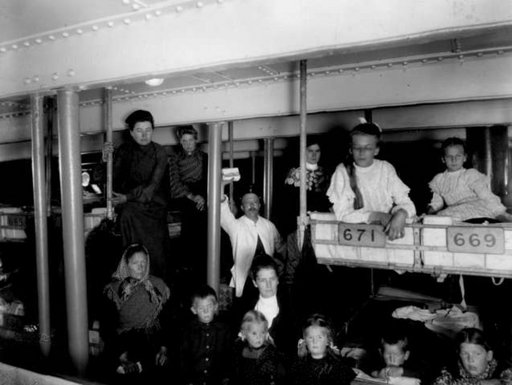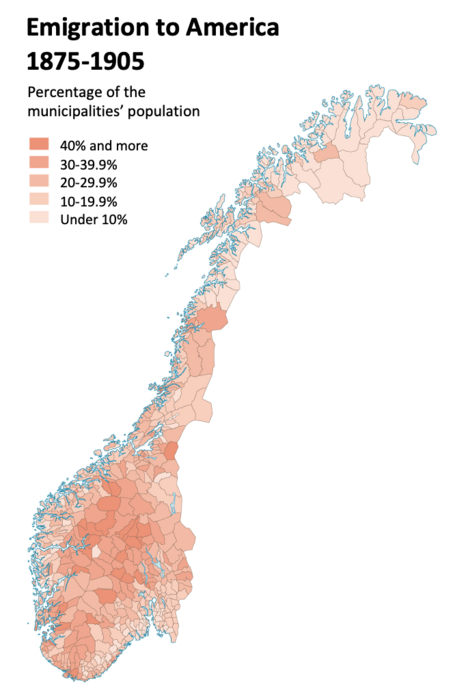Emigration from Norway, 1830-1920
800,000 Norwegians left their homes and moved to other countries between the years of 1830 and 1920. The majority went to North America, but many travelled to other continents, including Australia and New Zealand, or to South America, elsewhere in Europe, or even to Africa as missionaries.

Many Norwegians moved internally in Norway during this time period, and a large number of people from Sweden and elsewhere in Europe moved to Norway. However, by far the most visible and well-known type of migration between 1830 and 1920 was emigration from Norway. The reasons were manifold, but included employment opportunities elsewhere as well as the lure of America.
The first migrants to America

Norwegian emigration to America began in 1825 with a group of Quakers, led by Cleng Peerson. They wanted to escape a law called the ‘konventikkelplakaten’ which prohibited them from meeting as a congregation or religious community. Apart from some followers of Marcus Thrane, who emigrated in the 1850s, other Norwegians did not generally emigrate due to religious or political beliefs.
The first major wave of emigration came at the same time as the development of steamships in the 1860s. With sailing ships, the passage - which was dangerous and sometimes fatal - could take over two months. But the steamers crossed the Atlantic in just over a week, and deaths were a rarity. Conditions could be cramped, though, even aboard the steamers.
Three waves of Norwegian immigration to America
From the 1830s, emigration became quite commonplace, and from the mid-1860s decidedly prolific. There were three major waves:
- From 1866 to 1873;
- from the late 1870s to the early 1890s; and,
- from 1903 to around 1910.
In the peak year of 1882, 28,000 people emigrated. From then until the 1920s, about 800,000 people emigrated to American in total. A quarter of the emigrants eventually returned home, although that was not only a Norwegian phenomenon. Even if emigration varied greatly over time, it does not necessarily follow that certain age groups migrated more than others, only that emigration was usually deferred when times were good at home. About one-third of the population left the country during the heyday of emigration between the 1860s and 1910.
Emigration began from the villages
Emigration began from the inner fjords in Western Norway and the upper valleys in Eastern Norway. Afterwards, it spread to the lowlands and the coast. Many emigrants left the Southern counties during the shipping crisis around the year 1880. Later on, as many people emigrated from the city as from country villages. Northern Norway had relatively little emigration but received a large number of immigrants from the rest of the country.
Norwegians did not migrate due to poverty
Norwegian emigration, which lasted until World War I, was Europe's second largest in terms of the proportion of the population. Does this mean that people were particularly poverty-stricken in Norway? There is no doubt that the Norwegian countryside was relatively overpopulated and this played an important role. Economic crises, such as the one from the late 1870s, also influenced the situation. Nevertheless, it is important to emphasise that the level of need was not any worse in Norway than in other countries. Norway had strong economic growth and a relatively high standard of living.
The lure of America
Instead of poverty, it must have been the lure of America that drew people, and its appeal appeared to be greater for Norwegians than for most other Europeans. This is likely to have something to do with Norway's greater contact with the outside world through shipping and due to its population’s high standard of reading and writing skills. Once emigration had begun, contact with the home country ensured that this contact was maintained. Norwegian-American letters, money and tickets for the trip were sent and received.

Further reading:
- Ingrid Semmingsen, Veien mot vest I-II [The Road to the West] (Oslo, 1941/1950).
- Nils Olav Østrem, Norsk utvandringshistorie [Norwegian Emigration History] (Oslo, 2006).
Links:
- Theme page: Nordic social democracy in US politics.
- Thanks go to norgeshistorie.no for allowing us to translate this article. The original article can be read in Norwegian here.

